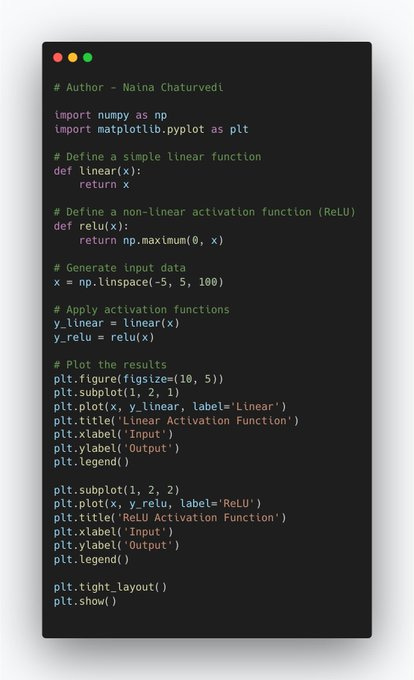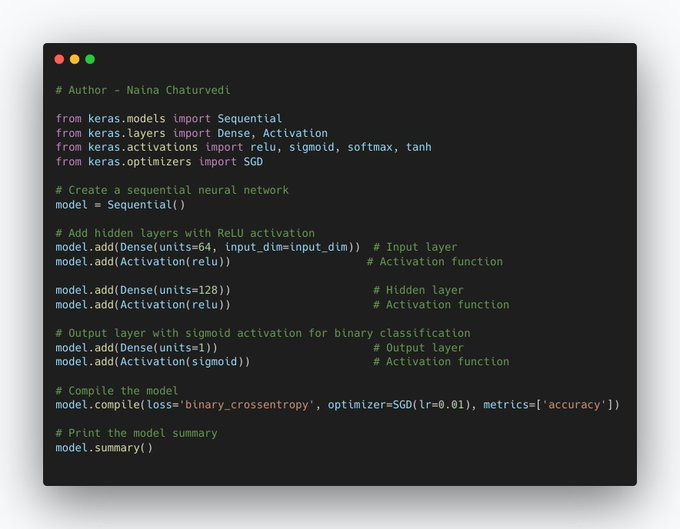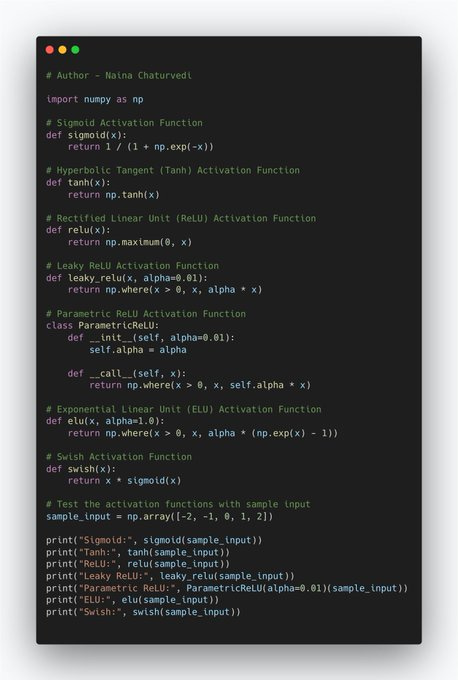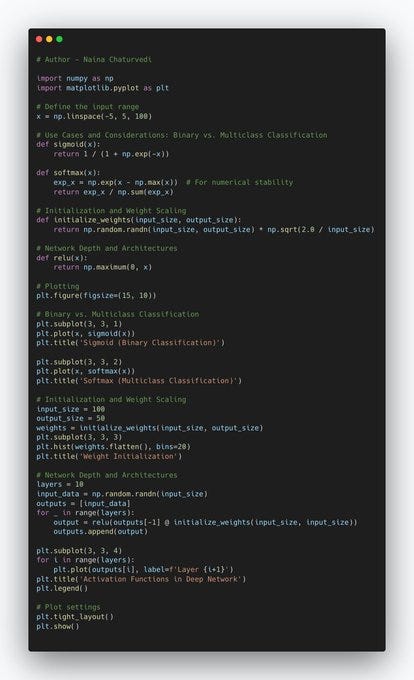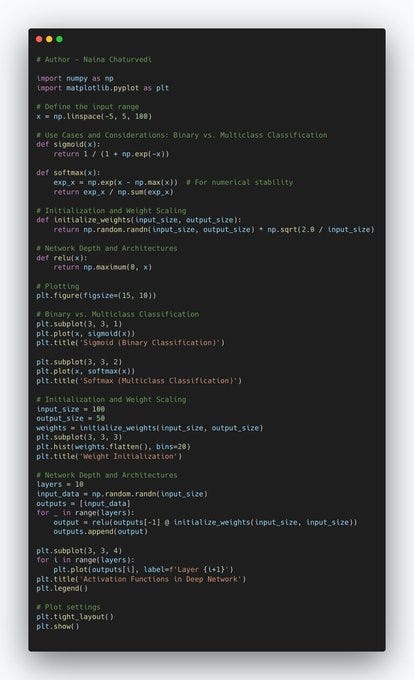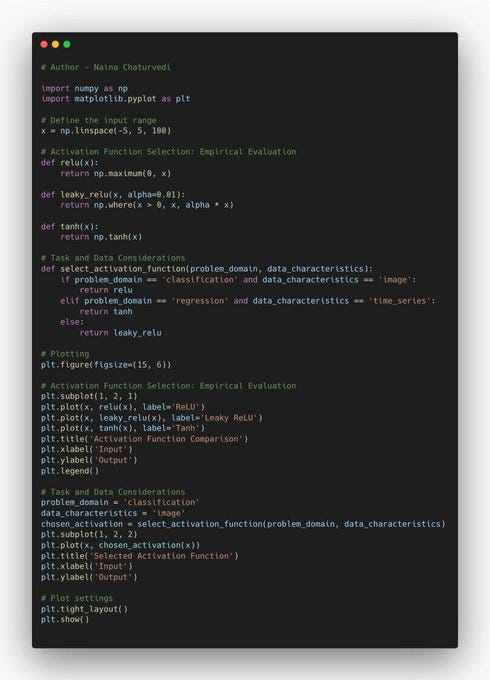Activation functions play a crucial role in neural networks, which are the building blocks of deep learning models.
1/ Imagine a magical machine that learns about animal pictures. This machine is like a puzzle, needing special buttons to work well. Activation functions are these buttons, helping the machine understand pictures differently – like seeing size, brightness, and importance.
2/ Pictures can be tricky, so these buttons act like special glasses, letting the machine see clearly. Activation functions are magic buttons that help the machine understand pictures by looking in various ways, similar to using different tools for a puzzle's different parts.
3/ An activation function is a mathematical function applied to the output of a neuron in an artificial neural network. Neurons take in inputs, multiply them by weights, sum them up, and then pass the result through an activation function.
Activation functions are an essential part of neural networks that help them understand and learn from data. They play a critical role in introducing non-linearity to the network, which is crucial for the network's ability to learn complex relationships and patterns.
5/ Hidden Layers: In hidden layers of a neural network, activation functions help introduce non-linearity to the model. Without them, network would be limited to learning only linear transformations of input data. Non-linearity allows the network to capture intricate patterns.
6/ Output Layer: The choice of activation function in the output layer depends on the nature of the task. For example, in binary classification tasks, the sigmoid activation function is often used to squash the output into a range between 0 and 1, representing a probability.
7/ Vanishing Gradient Problem: Activation functions can also help mitigate vanishing gradient problem, which can slow down training. Activation functions like ReLU and its variants maintain larger gradients for positive inputs, which prevents gradients from becoming very small.
8/ Feature Extraction: Activation functions allow neural networks to extract important features from the input data. Different activation functions emphasize different aspects of the data. For instance, ReLU focuses on positive values, which helps the network pick up on features
9/ Normalization and Transformation: Activation functions like the Tanh function, can normalize and transform data, making it suitable for certain tasks or improving convergence during training.
10/ Sigmoid: Range and Historical Significance: The sigmoid activation function squashes input values to a range between 0 and 1. It was historically used as a popular activation function, in neural networks, due to its nice properties like smoothness and interpretable outputs.
11/ Vanishing Gradient Problem: Sigmoid's saturating nature causes vanishing gradient problem. As inputs move towards the extremes (very high or very low values), the gradient becomes very small. This leads to slow learning and can cause the network to get stuck during training.
12/ Hyperbolic Tangent (Tanh): Range and Similarities with Sigmoid: The tanh activation function also squashes input values, but this time to a range between -1 and 1. Tanh is similar to sigmoid in shape but is zero-centered, meaning its average output is closer to zero.
13/ Mitigating Vanishing Gradient: While tanh helps mitigate the vanishing gradient problem compared to sigmoid due to its zero-centered nature, it can still suffer from similar issues when inputs are far from zero.
14/ Rectified Linear Unit (ReLU): Benefits: ReLU is a very simple activation function that outputs the input if it's positive and zero otherwise. Its simple computation speeds up training since it avoids complex exponentials or logarithms.
15/ Dying ReLU and Solutions: The dying ReLU problem occurs when the output is always zero, making the neuron ineffective during training. Leaky ReLU and Parametric ReLU are solutions that allow a small gradient to flow even when the unit is not active, preventing dying ReLU.
16/ Leaky ReLU and Parametric ReLU: Allowing Small Gradient: Leaky ReLU and Parametric ReLU are variants of ReLU that allow a small gradient (usually a small fraction of the input) to pass through when the unit is not active.
17/ Adaptability of Parametric ReLU: Parametric ReLU takes this a step further by learning the slope of the function for negative inputs. This adaptability helps the network learn better representations.
18/ Exponential Linear Unit (ELU): Ability to Handle Negative Inputs: ELU is another solution to the dying ReLU problem. It has a smooth transition for negative inputs, which helps avoid dead neurons. It also has non-zero gradients for all inputs, making learning more stable.
19/ Swish: Self-Gated Activation: Swish is a relatively newer activation function that uses a self-gating mechanism. It's similar to ReLU but has a sigmoid-like component that can adjust the output smoothly.
20/ Performance: Swish often performs better than ReLU in certain scenarios, although it might not always be the best choice. It combines some benefits of ReLU and sigmoid-like functions.
21/ Binary Classification: In binary classification, the task is to categorize inputs into two classes. Activation functions like the sigmoid function are commonly used in the output layer. Sigmoid squashes the output between 0 and 1.
22/ Multiclass Classification: For tasks with multiple classes, activation functions like the softmax function are more suitable in the output layer. Softmax normalizes the outputs into a probability distribution over all classes.
23/Initialization and Weight Scaling: Importance of Weight Initialization: Weight initialization is crucial because it sets the starting point for the learning process. Poor initialization can lead to issues like vanishing or exploding gradients.
24/ Gradient Vanishing/Exploding: During backpropagation, gradients can become extremely small (vanishing) or extremely large (exploding), which affects how the network updates its weights.
25/ Importance of Trying Multiple Activation Functions: Performance Variation: Different activation functions can perform differently on various tasks and datasets. What works well for one problem might not work as effectively for another.
26/ Avoiding Local Minima: Neural networks can sometimes get stuck in local minima during training. Trying various activation functions and architectures increases the chances of finding a configuration that helps the network escape such minima and achieve better results.
27/ Exploring Network Complexity: Different architectures involve varying levels of complexity and computational cost. By trying different architectures, you can strike a balance between model complexity and performance.
28/ Which Activation Function to choose and when - Classification vs. Regression: The nature of problem plays a role. For classification tasks, activation functions like ReLU, sigmoid, or softmax in o/p layer are common. For regression tasks, linear activation or tanh.
29/ Data Characteristics: Data characteristics, such as scale and distribution, matter. Activation functions like ReLU and its variants are well-suited for sparse and large-scale data, while tanh and sigmoid might be better for normalized data.
30/ Non-Linearity Requirement: If your problem involves complex relationships, non-linear activation functions like ReLU, tanh, or sigmoid are essential. If the problem is relatively linear, linear activation might suffice.
31/ Vanishing Gradient Concerns: If you're working with deep networks, using activation functions that mitigate vanishing gradients, like ReLU and its variants, can be beneficial.
Must know concepts before you dive in the research papers ( Explained) —
Transformer Link
TransformerXL Link
VGG Link
Mask RCNN Link
Masked Autoencoder Link
BEiT Link
BERT Link
ColD Fusion Link
ConvMixer Link
Deep and Cross Network Link
DenseNet Link
DistilBERT Link
DiT Link
DocFormer Link
Donut Link
EfficientNet Link
ELMo Link
Entity Embeddings Link
ERNIE-Layout Link
FastBERT Link
Fast RCNN Link
Faster RCNN Link
MobileBERT Link
MobileNetV1 Link
MobileNetV2 Link
MobileNetV3 Link
RCNN Link
ResNet Link
ResNext Link
SentenceBERT Link
Single Shot MultiBox Detector (SSD) Link
StructuralLM Link
Swin Transformer Link
TableNet Link
TabTransformer Link
Tabular ResNet Link
TinyBERT Link
Vision Transformer Link
Wide and Deep Learning Link
Xception Link
XLNet Link
AlexNet Link
BART Link
InceptionNetV2 and InceptionNetV3 Link
InceptionNetV4 and InceptionResNet Link
Layout LM Link
Layout LM v2 Link
Layout LM v3 Link
Lenet Link
LiLT Link
Feature Pyramid Network Link
Feature Tokenizer Transformer Link
Focal Loss (RetinaNet) Link
Projects
Implemented Data Science and ML projects : https://bit.ly/3H0ufl7
Implemented Data Analytics projects : https://bit.ly/3QSy2p2
Complete ML Research Papers Summarized : https://bit.ly/3QVb5kY
Implemented Deep Learning Projects : https://bit.ly/3GQ56Ju
Implemented Machine Learning Ops Projects : https://bit.ly/3HkVYy1
Implemented Time Series Analysis and Forecasting Projects : https://bit.ly/3HhJ82D
Implemented Applied Machine Learning Projects : https://bit.ly/3GX1SEm
Implemented Tensorflow and Keras Projects : https://bit.ly/3JmGw6f
Implemented PyTorch Projects : https://bit.ly/3WuwbYu
Implemented Scikit Learn Projects : https://bit.ly/3Wn9KV7
Implemented Big Data Projects : https://bit.ly/3kwF7zv
Implemented Cloud Machine Learning Projects : https://bit.ly/3ktKaka
Implemented Neural Networks Projects : https://bit.ly/3J4Js71
Implemented OpenCV Projects : https://bit.ly/3iNKcmF
Implemented Data Visualization Projects : https://bit.ly/3XDpm8a
Implemented Data Mining Projects : https://bit.ly/3kqViy5
Implemented Data Engineering Projects : https://bit.ly/3WHFXqF
Implemented Natural Leaning Processing Projects : https://bit.ly/3Hj1Is6

